ENVIRONMENTAL HAZARD IDENTIFICATION ASSESSMENT AND CONTROL FOR A SUSTAINABLE MARITIME TRANSPORTATION SYSTEM
Executive summary
This report highlights sustainability of the maritime, in this case it can be seen that trade plays an important role in the growth of the economy of the country. In this case it can be seen that trade through ocean is increasing over the year as it decreases the emission of Co2.
This also enhances the efficiency of the transportation. It can be stated that in case the researcher was unable to gather data from the authentic source then this situation will leave an impression on the outcome of the project. Apart from this, it can be stated that this situation in the country is also increasing the emission of carbon dioxide, by the year 2050 this will reach 50%.
The maritime transportation system (MTS) holds an important position in the transport system as it contributes to almost 90% of global trade. It can be observed that the ship transportation system provides a very low emission of greenhouse gases and thus the level of pollution due to the shipping is very low.
The main aim of the report is to analyze the direct impact of the maritime transport system on environmental issues. The report has also focused on the fact on how to improve the maritime system for the betterment of the environment.
The maritime transportation system contributes, the most important part of the global transportation system. It can be observed that the maritime system is crucial for the mass transport system because it allows a very low level of greenhouse gas emission.
Therefore, it can be observed that this system is very much eco-friendly and thus it has a great impact on the future transport system. As per the report of 2012, it can be observed that the maritime system used to emit 2.2% of the greenhouse gas and approximate 1.9% of carbon dioxide gas into the environment (Mestre et al, 2017).
As a result of this, most of the customers and the stakeholders are putting effort in order to improve the maritime system so that it can put a great sign on the global trade. As per the opinion of Lemly (2019), it is important to first identify the environmental impacts due to the transportation system and based on this analysis, the environmental strategies are needed to be prepared.
All these effective environmental strategies are needed to be incorporated in the maritime system so that it can become the most meticulous of mass transport systems across the globe.
Aim
The main aim of the report is to understand the impact of the maritime system on the environmental hazard and also to make a sustainable development plan to make this system as the future mass transport system.
Objective
The main objectives of this report are-
- To analyze the impact of the maritime system on the environmental hazard.
- To identify a proper sustainable development plan in order to involve all the environmental strategies into the maritime system.
- To evaluate the technology in order to improve all of its techniques of the system in order to reduce the hazardous emission into the environment.
The report has mainly focused on the port system located in North America, namely The Port of Prince Rupert (PPR). This port area is totally detached from the local communities and thus this area has been selected for the ideal research purpose on the effect of maritime system on the environmental hazards.
From the view of Lors et al, (2018), it can be observed that due to the increase in traffic numbers, the sizes of the ports are also increasing rapidly. Therefore, it is important to pay more attention to the impact of this increasing port size as well as the marine transport system onto the environment.
As a result of this, the review of literature has mainly focused on the sustainable development of the maritime system in order to understand the importance of this MTS system. As per the opinion of Vassallo et al, (2018), it can be observed that a system is generally termed as a sustainable system when there is a balance between their business entity and also on the impact on the environment.
3.1 Concept of environmental hazards
Environmental hazards mainly refer to as the state of the environment that affects the normal condition of nature along with the health of each and every living creatures on the earth.
All these environmental hazards increase the level of pollution and put a great negative impact on the health of humans as well as living creatures. According to Lors et al, (2018), it can be observed that in the maritime system, it also creates several environmental hazards that can affect the normal condition of nature.
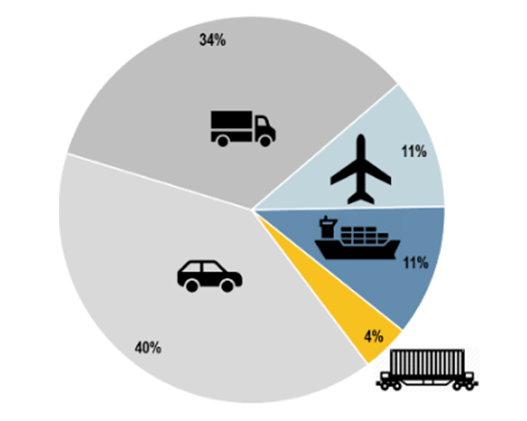
Figure 1: Greenhouse gas emission due to different transport system
(Source: Gustavsson et al, 2017)
It can be observed that due to the maritime system, a huge amount of greenhouse has used to generate. The huge percentage of greenhouse gas increase the level of pollution and also causes global warming which has become one of the most serious concern nowadays.
As argued by Gustavsson et al, (2017), the oil secreted due to marine transport also hampers the living ecosystem of water and therefore, all these need to pay more attention. However, it can be observed that the maritime transport system generates a very low among of greenhouse gas, but it needs to get more advanced to get a better result in the future.
3.2 Concept of the sustainable maritime system
The maritime system mainly refers to the ship security system that is used to maintain the safety, security, and navigation and tracking system of any kind of marine transport. It can be observed that marine transport constitutes about 90% of the world’s transport system.
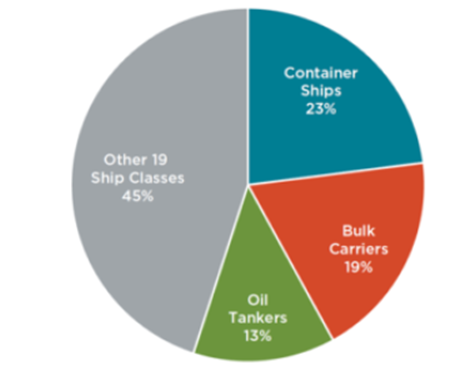
Figure 2: Rate of environmental hazards due to the maritime transport system
(Source: Leopold et al, 2017)
Sustainable development mainly refers to where the system allows both the safety of the passengers and also for the environment. As argued by Leopold et al, (2017), the level of pollution is also comparatively lower than any other transport system. Therefore, it serves as the most convenient and eco-friendly transport method for future purposes.
3.3 Effect of environmental hazards on the sustainable development of the maritime system
As the population is increasing day by day, the number of transport systems is also increasing. As mentioned by Thomas et al, (2019), the maritime transport system is comparatively more eco-friendly and thus it needs to incorporate all the new technologies in order to reduce the hazards rate in the environment.
Therefore, from the view of Pham et al, (2017), it is advisable first to identify all the environmental hazards due to the maritime transport system. Based on the analysis it is important to make the strategies that are needed to incorporate in the system.
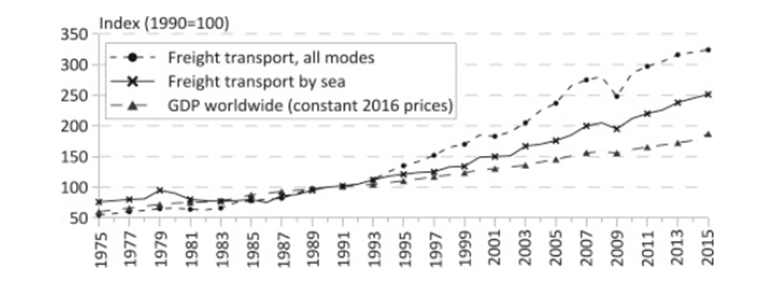
Figure 3: Maritime transport system in the world transport system
(Source: Li et al, 2019)
For example, the maritime transport system needs to improve the air pollution checking system before emitting the gases in the environment. Along with this, it is important to check the spill of oil in the environment so that it cannot hamper the marine environment along with marine life.
As argued by Li et al, (2019), the maritime organization needs to identify the customer’s expectation and the methods in which it can be incorporated in the system. Along with this, it is also important to understand how all these affecting the environment and also need to find remedies according to the hazards.
The literature gap mainly represents the missing part of the research work that has an adverse effect on the research work. In this research work, it can be observed that due to the lack of time and the limitation of the budget for the research work, the analysis of the sample has not been properly done.
It was reported that only a few of the environmental hazards have been identified and based on only those hazards the recovery plan has been set. As a result of this, it lacks many more hazards which are as important as all these and also need to be focused on.
The system thinking is an approach that focuses on the analysis of the system parts that are interrelated. According to Hu et al. (2019), it can be stated that this system gives an idea about the interconnectivity between the components that are given within the system and throughout the other system.
Moreover, this also helps to solve the problems of the system. This will also address the data collection and data analysis method for the research work. On the other hand the secondary data collection method is the data that is gathered through the internet or any other sources.
In this case, the researcher selected the secondary data in order to get an idea about the research work. In addition, it can be stated that this has also enabled them to analyze the situation by gathering secondary data for the research work.
The data collection methods can be specified into two parts, one is the primary data collection method and others can be named as the secondary data collection method. As stated by Rodriguez‐Gil et al. (2017), the primary data gathering is the gathering of the data directly from the sources.
On the other hand the secondary data collection method is the data that is gathered through the internet or any other sources. In this case the researcher selected the secondary data in order to get an idea about the research work.

Figure 4: Data collection method
(Source: Rodriguez‐Gil et al. 2017)
The data analysis method can be divided into two parts: quantitative data and qualitative data. According to Kadir et al. (2020), the quantitative data analysis represents the statistical data analysis of the data that is gathered, whereas the qualitative data analysis is the thematic analysis of the data. In this case the researcher have considered the quantitative data analysis method, in addition, it can be stated that the researcher is aiming to analyze the data statistically.
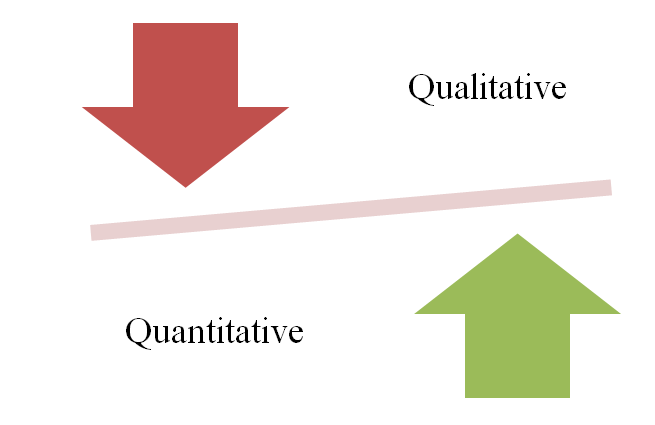
Figure 5: Data analysis method
(Source: Kadir et al. 2020)
The research philosophy is an important part of the research work, the research philosophy can be alienated into three parts positivism, interpretivism, and realism. As stated by Wróbel (2019), in this case, the researcher selected the positivism research philosophy that has allowed the researcher to analyze the data correctly. In addition, it can be stated that this has also enabled them to analyze the situation by gathering secondary data for the research work.
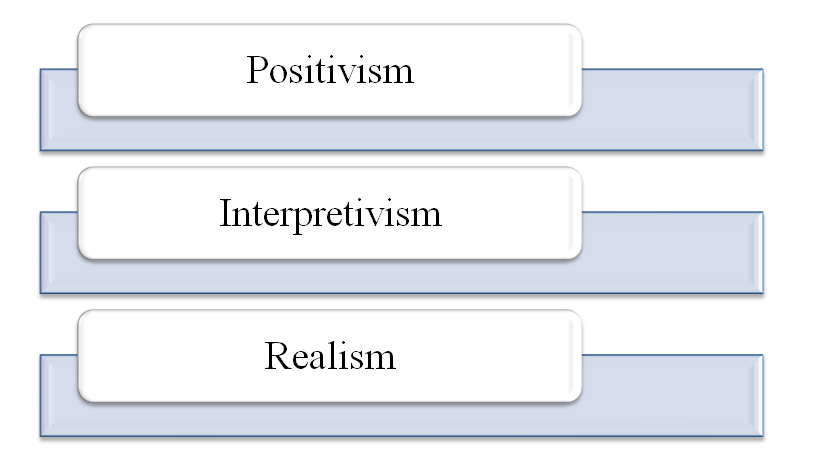
Figure 6: Research philosophy
(Source:Wróbel 2019)
The research approach helps the researcher in attaining the goal of the research work. The research approach can be alienated into two parts deductive research approach and inductive research approach. As stated by Smolarz et al. (2016),in this case, the researcher selected the deductive research approach in order to meet the goals of the research work, this has also enabled them to analyze the data that was gathered.

Figure 7: Research approach
(Source: Smolarz et al. 2016)
4.6 Research design
The research design cast light on the issues and the problems of the research work. Apart from this, the research work can be divided into three parts explanatory, exploratory and descriptive research design. A stated by Smolarz et al. (2016), in this case, the researcher has selected the descriptive research design. The descriptive research design of the research work allowed them to analyze the research data.
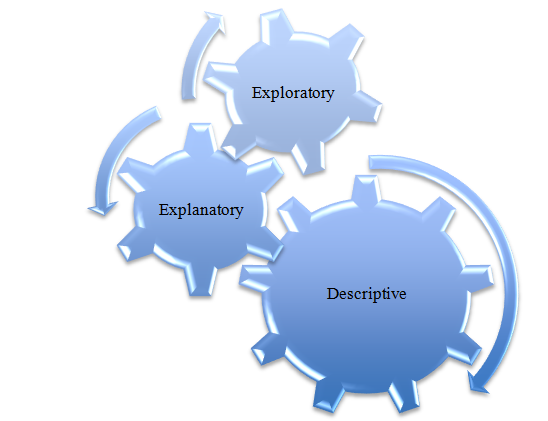
Figure 8: Research design
(Source: Smolarz et al. 2016)
5. Summary of ethical issues and addressing the ethical issues
Each and every researcher is bound under the ethics of the research work. In this case, the researcher has used authentic sources for the collection of the data. In addition, according to Wendler-Bosco and Nicholson, (2019), the researcher has gathered data from the journals and the journals are authentic, and the researcher has also presented the authentic data of the research work.
This, in turn, will also enable them to use the authentic source for the research work. In the case the researcher is unable to use the authentic data for the research work then this will have an impact on the outcome of the research work.
6. Involved risks and management of the risks
The research work involves a great amount of risk that can have an impact on the impression of the research work. In addition, according to Kadir et al. (2020) it can be stated that in case the researcher was unable to gather data from the authentic source then this situation will leave an impression on the outcome of the project.
Thus it can be stated that this situation can decrease the productivity of the research work. Apart from this, it also includes several risks like the reserve can face risk while gathering data.
The Maritime transportation system plays an important role in international trade. It can be seen that a large amount of trade can be done through maritime. In addition, it can be stated that this is considered as one of the cost-efficient and eco-friendly ways to transport the goods for trade.
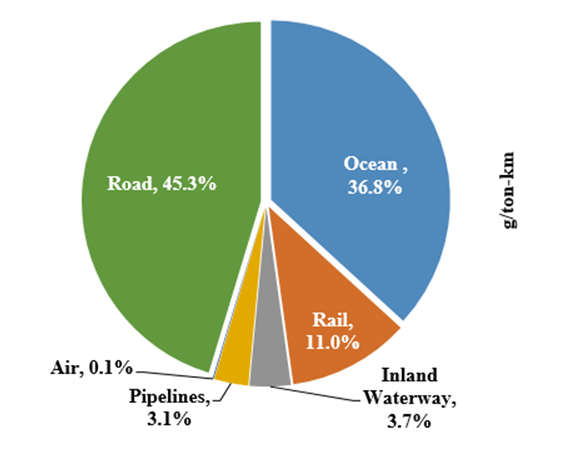
Figure 9: Transport mode
(Source: Lors et al. 2018)
From the above figure, it can be seen that 36.8% of total trade is done through the ocean and 45.35 trade is done by road. In addition, it can be seen that 11% of trade is done by railroad. Thus it can be stated that the ocean way is considered as one of the most efficient ways for the trade after road.
As this way decreases the pollution and also considered as one of the most efficient ways to transport goods. In case the mode of transport is considered then it can be seen that the capacity of the transport are discussed.
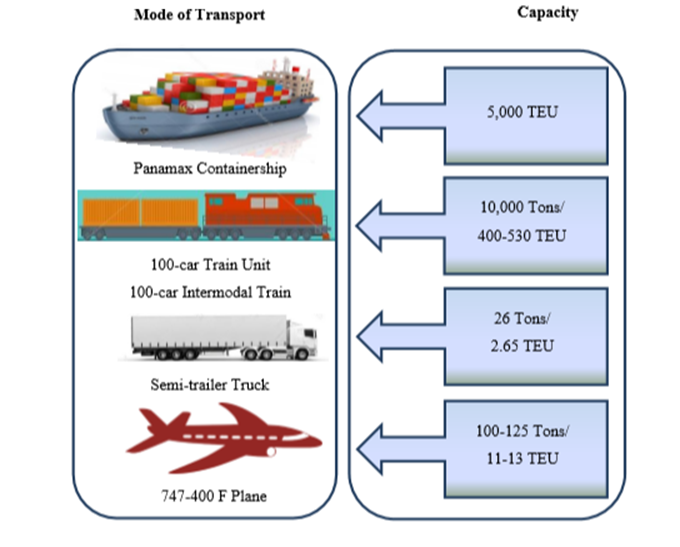
Figure 10: Capacity
(Source: Li et al. 2019)
The containership has a capacity of 5,000 TEU, this signifies that the ship has a high capacity to carry the containers. In addition, it can be stated that this situation also enhances the trade volume of the country.
In case the trade volume of the country enhances, in addition, this is also a cost-efficient way of transportation with lower emission of air. In case the fuel consumption is considered then it can be seen that the fuel consumption is increasing.
From the above figure, it can be seen that the fuel consumption of the container ship is lower than another mode of transportation.
In addition, it can be stated that traffic is increasing as the volume of international trade is increasing. As a result of that it can be stated that the emission of carbon dioxide was 2% in the year 2012 and the emission of carbon dioxide will increase to 50% by the year 2050.
8. Work plan for the research work
Based on the above study it can be seen that trade plays an important role in the economic growth of the country. In case the transportation of the country enhances then this will also trade volume of the country.
It can be seen that the ocean transportation is increasing as it decreases the cost of transportation. In addition, it can be stated that the researcher has considered secondary data for the analysis. In addition, it can be stated that in case the researcher was unable to gather data from the authentic source then this situation will leave an impression on the outcome of the project.
Apart from this, it can be stated that this situation in the country is also increasing the emission of carbon dioxide, by the year 2050 this will reach 50%.
Gustavsson, M.B., Hellohf, A. and Backhaus, T., 2017. Evaluating the environmental hazard of industrial chemicals from data collected during the REACH registration process. Science of The Total Environment, 586, pp.658-665.
Hu, G., Mian, H.R., Hewage, K. and Sadiq, R., 2019. An integrated hazard screening and indexing system for hydraulic fracturing chemical assessment. Process Safety and Environmental Protection, 130, pp.126-139.
Kadir, Z.A., Mohammad, R., Othman, N., Amrin, A., Muhtazaruddin, M.N., Abu-Bakar, S.H. and Muhammad-Sukki, F., 2020. Risk Management Framework for Handling and Storage of Cargo at Major Ports in Malaysia towards Port Sustainability. Sustainability, 12(2), p.516.
Lemly, A.D., 2019. Environmental hazard assessment of Benga Mining’s proposed Grassy Mountain Coal Project. Environmental science & policy, 96, pp.105-113.
Leopold, A., Roberts, M. and Matthiessen, P., 2017. Ecotoxicological hazard and risk assessment of endocrine active substances. Integrated environmental assessment and management, 13(2), pp.264-266.
Li, H.H., Yauk, C., Chen, R., Hyduke, D.R., Williams, A., Frötschl, R., Ellinger-Ziegelbauer, H.C., Pettit, S., Aubrecht, J. and Fornace Jr, A.J., 2019. TGx-DDI, a transcriptomic biomarker for genotoxicity hazard assessment of pharmaceuticals and environmental chemicals. Frontiers in Big Data, 2, p.36.
Lors, C., Ponge, J.F. and Damidot, D., 2018. Environmental hazard assessment by the Ecoscore system to discriminate PAH-polluted soils. Environmental Science and Pollution Research, 25(27), pp.26747-26756.
Lors, C., Ponge, J.F. and Damidot, D., 2018. Microscopy in addition to chemical analyses and ecotoxicological assays for the environmental hazard assessment of coal tar-polluted soils. Environmental Science and Pollution Research, 25(3), pp.2594-2602.
Mestre, N.C., Rocha, T.L., Canals, M., Cardoso, C., Danovaro, R., Dell’Anno, A., Gambi, C., Regoli, F., Sanchez-Vidal, A. and Bebianno, M.J., 2017. Environmental hazard assessment of a marine mine tailings deposit site and potential implications for deep-sea mining. Environmental Pollution, 228, pp.169-178.
Pham, B.T., Bui, D.T., Pham, H.V., Le, H.Q., Prakash, I. and Dholakia, M.B., 2017. Landslide hazard assessment using random subspace fuzzy rules based classifier ensemble and probability analysis of rainfall data: a case study at Mu Cang Chai District, Yen Bai Province (Viet Nam). Journal of the Indian Society of Remote Sensing, 45(4), pp.673-683.
Rodriguez‐Gil, J.L., Prosser, R., Poirier, D., Lissemore, L., Thompson, D., Hanson, M. and Solomon, K.R., 2017. Aquatic hazard assessment of MON 0818, a commercial mixture of alkylamine ethoxylates commonly used in glyphosate‐containing herbicide formulations. Part 1: Species sensitivity distribution from laboratory acute exposures. Environmental toxicology and chemistry, 36(2), pp.501-511.
Smolarz, K., Biskup, P. and Zgrundo, A., 2016. Biological invasions: a case study of Baltic Sea environmental governance. In Environmental governance of the Baltic Sea (pp. 73-95). Springer, Cham.
Thomas, P.C., Bicherel, P. and Bauer, F.J., 2019. How in silico and QSAR approaches can increase confidence in environmental hazard and risk assessment. Integrated environmental assessment and management, 15(1), pp.40-50.
Vassallo, J., Besinis, A., Boden, R. and Handy, R.D., 2018. The minimum inhibitory concentration (MIC) assay with Escherichia coli: an early tier in the environmental hazard assessment of nanomaterials?. Ecotoxicology and environmental safety, 162, pp.633-646.
Wendler-Bosco, V. and Nicholson, C., 2019. Port disruption impact on the maritime supply chain: a literature review. Sustainable and Resilient Infrastructure, pp.1-17.
Wróbel, K., Krata, P. and Montewka, J., 2019. Preliminary results of a system-theoretic assessment of maritime autonomous surface ships’ safety. TransNav, International Journal on Marine Navigation and Safety od Sea Transportation, 13(4).
| Week 1 | Week 2 | Week 3 | Week 4 | Week 5 | Week 6 | Week 7 | |
| Topic Selection | ● | ||||||
| Creating layout | ● | ||||||
| Literature review | ● | ● | ● | ||||
| Formation of plan for research | ● | ● | |||||
| Selection of Research Techniques | ● | ● | |||||
| Secondary data collection | ● | ● | |||||
| Analysis of Data Collection | ● | ● | |||||
| Data Findings | ● | ||||||
| Conclusion of Study | ● | ||||||
| Rough Draft Formation | ● | ● | |||||
| Submission of Final Work | ● | ● |

